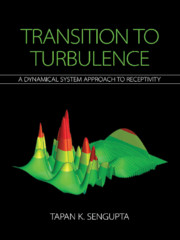Book contents
- Frontmatter
- Dedication
- Contents
- Preface
- 1 Receptivity, Instability, and Transition: A Perspective
- 2 Dynamical System Theory and Role of Equilibrium Flows
- 3 Fundamentals of Scientific Computing
- 4 Instability and Transition
- 5 Receptivity Analysis: Relation with Instability Experiments
- 6 Dynamical System Theory of Linear Receptivity
- 7 Nonlinear, Nonparallel Effects on Receptivity, Instability, and Transition
- 8 Three-Dimensional Routes of Transition to Turbulence
- 9 Receptivity to Free Stream Excitation: Theory, Computations, and Experiments
- 10 Nonlinear Receptivity Theories: Hopf Bifurcations and Proper Orthogonal Decomposition for Instability Studies
- 11 Mixed Convection Flow
- 12 Baroclinic Instability: Rayleigh–Taylor Instability
- 13 Coherent Structure Tracking in Transitional and Turbulent Flows
- 14 The Route of Transition to Turbulence: Solution of Global Nonlinear Navier–Stokes Equation
- References
7 - Nonlinear, Nonparallel Effects on Receptivity, Instability, and Transition
Published online by Cambridge University Press: 16 February 2021
- Frontmatter
- Dedication
- Contents
- Preface
- 1 Receptivity, Instability, and Transition: A Perspective
- 2 Dynamical System Theory and Role of Equilibrium Flows
- 3 Fundamentals of Scientific Computing
- 4 Instability and Transition
- 5 Receptivity Analysis: Relation with Instability Experiments
- 6 Dynamical System Theory of Linear Receptivity
- 7 Nonlinear, Nonparallel Effects on Receptivity, Instability, and Transition
- 8 Three-Dimensional Routes of Transition to Turbulence
- 9 Receptivity to Free Stream Excitation: Theory, Computations, and Experiments
- 10 Nonlinear Receptivity Theories: Hopf Bifurcations and Proper Orthogonal Decomposition for Instability Studies
- 11 Mixed Convection Flow
- 12 Baroclinic Instability: Rayleigh–Taylor Instability
- 13 Coherent Structure Tracking in Transitional and Turbulent Flows
- 14 The Route of Transition to Turbulence: Solution of Global Nonlinear Navier–Stokes Equation
- References
Summary
Introduction
Experimental study of flow transition began with the famous pipe flow experiment [365], in which Reynolds took pipes of different diameters and fitted them carefully with bell-mouth shaped entry sections. In Chapter 4, one noted that favorable pressure gradient delays transition by attenuating disturbances. The bell-mouth accelerates the flow, and the resultant favorable pressure gradient stabilizes the flow. Apart from this, Reynolds took other precautions to note that the transition in the pipe flow depends upon the non-dimensional parameter, now known as the Reynolds number, Re = Vd/ν, where V is the centreline velocity and d is the diameter of the pipe. He found that with all extra precautions taken against disturbance growth, the flow can be kept laminar up to Re = 12, 830. It was also noted by Reynolds that this critical value is very sensitive to disturbances in the oncoming flow, before it enters the pipe. Although this might also indicate receptivity of the flow, Reynolds remarked that “this at once suggested the idea that the condition might be one of instability for disturbance of certain magnitude and stable for smaller disturbances.” The relation between input and output amplitudes during disturbance growth is a typical attribute of nonlinear instability. There are other flows, e.g. the Couette flow, which are found to be linearly stable for all Reynolds numbers. This prompted researchers [282, 298] to suggest nonlinear routes of instabilities for such flows. However, it is interesting to note that some authors [399] have stated without proof that “it is easy to verify that the nonlinear terms of the incompressible Navier–Stokes equations are energy preserving: the role of the nonlinear terms is the distribution, scattering and transfer of energy, but this reorganization is accomplished in a conservative manner. Energy growth or decay can only come from linear processes.” The presented explanation in this book is contrary to this point of view, with enough evidences provided to show the central and important role of nonlinearity in causing transition [471].
One of the constraints of classical linear instability theories performing local analysis is the adoption of the parallel flow assumption of the equilibrium flow. This has been addressed in review articles by Chomaz [93] and Theofilis [519], with the main emphasis on giving up on local analysis in favor of a global analysis.
- Type
- Chapter
- Information
- Transition to TurbulenceA Dynamical System Approach to Receptivity, pp. 212 - 247Publisher: Cambridge University PressPrint publication year: 2021



